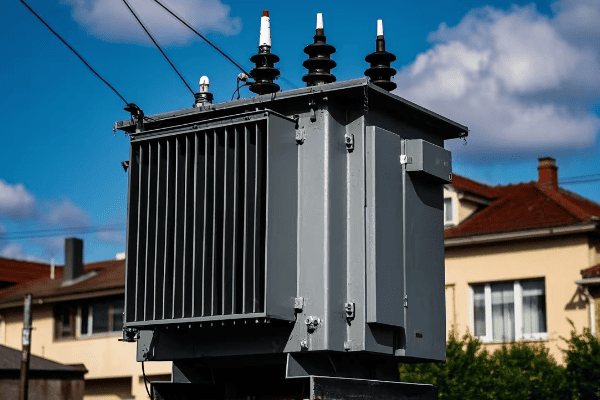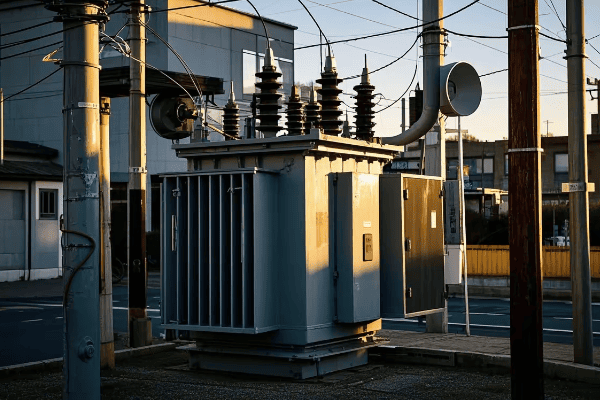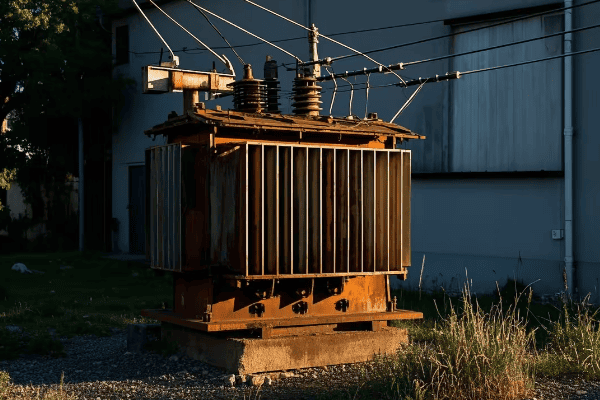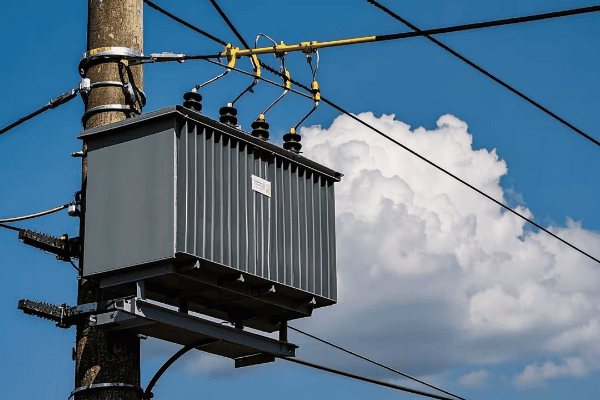Have you ever wondered what keeps your lights on and your devices charged? The answer lies in a device you rarely see but heavily rely on: the electrical transformer.
Electrical transformers are the unsung heroes of our power systems. They change voltage levels, enabling efficient power transmission over long distances and safe distribution to our homes and businesses. Without them, our modern electrical grid simply wouldn't function.

As an electrical engineer with years of experience in the power industry, I've seen firsthand how crucial these devices are. Let's explore why electrical transformers are truly the backbone of our modern power systems.
How Electrical Transformers Ensure the Stability and Resilience of Modern Power Grids?
Imagine trying to balance a tower of blocks while someone keeps adding and removing pieces. That's similar to the challenge our power grids face every day, and transformers are the key to maintaining this delicate balance.
Electrical transformers ensure grid stability by regulating voltage levels, managing power flow, and isolating faults. They act as buffers between different parts of the grid, preventing disturbances from spreading and maintaining a steady power supply.

Let's dive deeper into how transformers contribute to grid stability and resilience:
Voltage Regulation
Transformers play a crucial role in maintaining consistent voltage levels throughout the grid. Here's how:
- Step-Up Transformers: At power plants, these increase voltage for long-distance transmission, reducing power losses.
- Step-Down Transformers: At substations, these reduce voltage for local distribution.
- On-Load Tap Changers (OLTC): Some transformers have OLTCs that can adjust voltage ratios while the transformer is energized, responding to changing load conditions.
Fault Isolation
Transformers help prevent faults from cascading through the entire grid:
- Electrical Isolation: Transformers provide a barrier between different voltage levels, preventing faults from propagating.
- Protective Relays: Modern transformers are equipped with relays that can detect faults and disconnect the transformer if necessary.
Power Flow Management
Transformers help manage the flow of power in complex grid networks:
- Phase-Shifting Transformers: These special transformers can control the direction of power flow, helping to balance loads across the grid.
- HVDC Converter Transformers: Used in high-voltage direct current systems, these enable efficient long-distance power transmission and connect asynchronous grids.
Here's a quick comparison of how different transformer types contribute to grid stability:
| Transformer Type | Primary Stability Function |
|---|---|
| Step-Up | Enables efficient long-distance transmission |
| Step-Down | Provides safe voltage levels for end-users |
| OLTC | Maintains consistent voltage under varying loads |
| Phase-Shifting | Controls power flow direction |
| HVDC Converter | Enables long-distance transmission and grid interconnection |
By performing these crucial functions, electrical transformers form the backbone of our power grids, ensuring the lights stay on even as demand fluctuates and unexpected events occur.
The Diverse Ecosystem of Electrical Transformers: From Generation to Consumption?
When I first started in this field, I was amazed by the variety of transformers I encountered. It's like a hidden world, with each type playing a unique role in getting power from the plant to your plug.
The electrical transformer ecosystem is incredibly diverse, with specialized types for every stage of power delivery. From massive generator step-up transformers at power plants to small distribution transformers in your neighborhood, each plays a crucial role in the power journey.

Let's explore this diverse ecosystem of transformers:
Power Generation Transformers
These are the giants of the transformer world, found at power plants:
-
Generator Step-Up Transformers:
- Increase voltage from generators (typically 15-25kV) to transmission levels (230kV-765kV)
- Can be as large as a house and weigh hundreds of tons
-
Unit Auxiliary Transformers:
- Provide power for the plant's own operations
- Typically step down voltage from generator output to medium voltage (4.16kV-13.8kV)
Transmission Transformers
These transformers handle the long-distance journey of electricity:
-
Auto-Transformers:
- Used for changing voltage between transmission levels (e.g., 345kV to 138kV)
- More efficient than two-winding transformers for voltage ratios less than 3:1
-
HVDC Converter Transformers:
- Used in high-voltage direct current systems
- Enable efficient long-distance transmission and connection of asynchronous grids
Substation Transformers
These are the workhorses that bring power closer to end-users:
-
Step-Down Transformers:
- Reduce transmission voltages to distribution levels (typically 4kV-34.5kV)
- Often equipped with on-load tap changers for voltage regulation
-
Regulating Transformers:
- Maintain constant voltage despite fluctuations in load or input voltage
- Use tap changers or separate regulating windings
Distribution Transformers
These are the final step in bringing power to consumers:
-
Pole-Mounted Transformers:
- Commonly seen on utility poles
- Reduce medium voltage to 120/240V for residential use
-
Pad-Mounted Transformers:
- Installed on ground-level concrete pads
- Used in underground distribution systems
-
Network Transformers:
- Used in urban areas with high power density
- Feed into networked secondary systems for improved reliability
Here's a comparison of these transformer types:
| Transformer Type | Typical Location | Primary Function | Typical Size Range |
|---|---|---|---|
| Generator Step-Up | Power Plants | Increase voltage for transmission | 100-1500 MVA |
| Auto-Transformer | Transmission Substations | Change between transmission voltages | 100-1000 MVA |
| Substation Step-Down | Distribution Substations | Reduce to distribution voltages | 5-100 MVA |
| Pole-Mounted | Utility Poles | Provide final voltage reduction for consumers | 10-167 kVA |
This diverse ecosystem of transformers works together to ensure that electricity is efficiently and safely delivered from power plants to end-users. Each type is optimized for its specific role, contributing to the overall reliability and efficiency of our power systems.
Evolution of Electrical Transformers: Meeting the Challenges of 21st Century Power Demands?
When I started in this industry, transformers were simpler. Now, they're evolving rapidly to meet new challenges. It's like watching a technological evolution in fast-forward.
Electrical transformers are evolving to meet 21st-century power demands. They're becoming more efficient, smarter, and adaptable. Modern transformers incorporate advanced materials, digital monitoring, and flexible designs to handle renewable energy integration and smart grid requirements.

Let's explore how transformers are evolving:
Advanced Materials
Modern transformers use innovative materials to improve performance:
-
Amorphous Metal Cores:
- Reduce no-load losses by up to 70% compared to traditional silicon steel
- Particularly useful in distribution transformers
-
High-Temperature Superconducting (HTS) Transformers:
- Use superconducting materials for windings
- Offer higher efficiency and smaller size, but still in development stage
-
Vegetable-Based Oils:
- Biodegradable and fire-resistant alternative to mineral oil
- Increasing use in distribution transformers
Smart Features
Transformers are getting smarter:
-
Digital Monitoring Systems:
- Real-time monitoring of temperature, oil condition, and load
- Enables predictive maintenance and improved asset management
-
On-Load Tap Changers (OLTC):
- Allow voltage adjustment without interrupting power flow
- Increasingly using vacuum technology for longer life and less maintenance
-
Integrated Sensors:
- Monitor key parameters like partial discharges and gas-in-oil
- Provide early warning of potential issues
Adaptability for Renewable Energy
Transformers are adapting to the challenges of renewable energy integration:
-
Bi-Directional Power Flow Capability:
- Handle power flow from distributed generation sources
- Important for integrating rooftop solar and small wind installations
-
Harmonic Mitigation:
- Design features to handle harmonics from inverter-based renewable sources
- Use of K-factor ratings to indicate ability to handle harmonic heating
-
Compact Designs:
- For use in offshore wind platforms or crowded urban solar installations
- High-frequency transformers for some renewable applications
Efficiency Improvements
Transformers are becoming more efficient:
-
Efficiency Standards:
- Regulations like the EU's Ecodesign Directive drive continuous efficiency improvements
- Focus on both loaded and no-load losses
-
Core Design Optimization:
- Use of step-lap core joints and laser-scribed laminations
- Reduces core losses and noise
-
Winding Optimization:
- Use of continuously transposed conductors (CTC) in larger transformers
- Reduces eddy current losses in windings
Here's a comparison of traditional and modern transformer features:
| Feature | Traditional Transformers | Modern Transformers |
|---|---|---|
| Core Material | Silicon Steel | Amorphous Metal or Advanced Silicon Steel |
| Cooling Medium | Mineral Oil | Mineral Oil, Ester Fluids, or Dry-Type |
| Monitoring | Basic gauges | Integrated digital monitoring systems |
| Efficiency | Meet basic standards | Exceed stringent efficiency regulations |
| Renewable Energy Compatibility | Limited | Designed for bi-directional power flow and harmonics |
These evolutions in transformer technology are crucial for meeting the power demands of the 21st century. They enable more efficient, reliable, and flexible power systems capable of integrating renewable energy and supporting smart grid initiatives.
Powering the Green Transition: Electrical Transformers and Renewable Energy Integration?
When I first started working with transformers, renewable energy was a small part of the power mix. Now, it's reshaping our entire industry. Transformers are at the forefront of this green revolution.
Electrical transformers play a crucial role in renewable energy integration. They handle the variable output of renewables, enable long-distance transmission from remote generation sites, and help maintain grid stability with fluctuating power inputs. Modern transformers are evolving to meet these unique challenges.

Let's explore how transformers are powering the green transition:
Handling Variable Output
Renewable sources like wind and solar have variable output. Transformers help manage this:
-
On-Load Tap Changers (OLTC):
- Adjust voltage ratios in real-time to handle fluctuations in renewable output
- Help maintain grid stability despite variable inputs
-
Wide Range Transformers:
- Designed to operate efficiently across a wide range of loads
- Important for solar installations where output varies throughout the day
Long-Distance Transmission
Many renewable sources are located far from population centers. Transformers enable efficient transmission:
-
HVDC Converter Transformers:
- Used in high-voltage direct current systems
- Enable efficient long-distance transmission from offshore wind farms or remote solar installations
-
Ultra-High Voltage (UHV) Transformers:
- Handle voltages of 1000kV AC or above
- Allow for very long distance transmission with minimal losses
Grid Stability
Transformers help maintain grid stability with high renewable penetration:
-
Phase Shifting Transformers:
- Control power flow in the grid
- Help manage the integration of large renewable energy sources
-
Static Synchronous Compensators (STATCOM) with Transformers:
- Provide reactive power compensation
- Help maintain voltage stability with variable renewable inputs
Bidirectional Power Flow
With distributed generation, power can flow both ways in the grid:
-
Distribution Transformers with Bidirectional Capability:
- Handle power flow from rooftop solar and other distributed sources
- Enable consumers to feed excess power back to the grid
-
Smart Transformers:
- Use power electronics to manage bidirectional power flow
- Can adjust quickly to changes in local generation and consumption
Here's a comparison of transformer applications in conventional and renewable energy systems:
| Aspect | Conventional Power | Renewable Energy |
|---|---|---|
| Power Flow | Mostly unidirectional | Often bidirectional |
| Output Stability | Relatively stable | Highly variable |
| Location | Near population centers | Often in remote areas |
| Harmonics | Limited | Significant due to inverters |
| Transformer Design | Standard | Specialized for renewables |
Transformers designed for renewable energy integration often incorporate these features:
- Enhanced Cooling Systems: To handle rapid load changes
- Robust Insulation: To withstand frequent voltage fluctuations
- Advanced Monitoring: To manage the complex behavior of renewable-heavy grids
- Harmonic Mitigation: To handle the harmonics introduced by inverters in solar and wind systems
As we continue to transition to a greener energy future, transformers will play an increasingly critical role. They're not just passive components, but active enablers of our renewable energy revolution.
Enhancing Grid Efficiency and Reliability: The Critical Role of Electrical Transformers?
In my years working with power systems, I've seen firsthand how crucial transformers are for grid efficiency and reliability. They're like the unsung heroes of our electrical infrastructure.
Electrical transformers are critical for enhancing grid efficiency and reliability. They minimize power losses, regulate voltage, isolate faults, and enable flexible power routing. Modern transformers with advanced monitoring and control features further improve grid performance and resilience.

Let's explore how transformers enhance grid efficiency and reliability:
Minimizing Power Losses
Transformers play a key role in reducing power losses in the grid:
-
Step-Up Transformers:
- Increase voltage for long-distance transmission
- Higher voltage means lower current for the same power, reducing I²R losses in transmission lines
-
Efficient Core Materials:
- Modern transformers use advanced materials like amorphous metals
- These can reduce no-load losses by up to 70% compared to traditional silicon steel
-
Optimized Winding Design:
- Use of continuously transposed conductors (CTC) in larger transformers
- Reduces eddy current losses in windings
Voltage Regulation
Transformers help maintain stable voltage levels throughout the grid:
-
On-Load Tap Changers (OLTC):
- Adjust voltage ratios without interrupting power flow
- Help maintain consistent voltage despite load variations
-
Voltage Regulating Transformers:
- Specialized transformers that can fine-tune voltage levels
- Often used in distribution systems to compensate for voltage drop
Fault Isolation
Transformers help prevent faults from cascading through the grid:
-
Impedance Isolation:
- Transformer impedance limits fault currents
- Helps contain faults to smaller sections of the grid
-
Differential Protection:
- Modern transformers use differential relays
- These can quickly detect and isolate internal faults
Flexible Power Routing
Transformers enable flexible power routing in the grid:
-
Phase Shifting Transformers:
- Control active power flow in parallel transmission paths
- Help optimize grid loading and prevent overloads
-
HVDC Converter Transformers:
- Enable interconnection of asynchronous grids
- Allow for more flexible power exchange between regions
Advanced Monitoring and Control
Modern transformers incorporate features that enhance grid management:
-
Digital Monitoring Systems:
- Real-time monitoring of key parameters
- Enables predictive maintenance and faster fault response
-
Smart Transformers:
- Incorporate power electronics for enhanced control
- Can adapt to changing grid conditions in real-time
Here's a comparison of how different transformer features contribute to grid efficiency and reliability:
| Feature | Efficiency Impact | Reliability Impact | |||
|---|---|---|---|---|---|
| Efficient Core Materials | Reduces no-load losses | Improves long-term performance | |||
| On-Load Tap Changers | Optimizes voltage for efficiency | Maintains stable voltage | Fault Isolation | Minimizes power interruptions | Prevents widespread outages |
| Phase Shifting | Optimizes power flow | Prevents overloads | |||
| Digital Monitoring | Enables efficiency optimization | Allows predictive maintenance |
These features work together to create a more efficient and reliable grid. Let's dive deeper into some key aspects:
Energy Efficiency Improvements
Transformer efficiency directly impacts overall grid efficiency:
-
Efficiency Standards:
- Regulations like the EU's Ecodesign Directive drive continuous improvements
- For example, Tier 2 of this directive mandates minimum efficiencies for large power transformers
-
Total Cost of Ownership (TCO) Approach:
- Utilities now consider lifetime energy costs, not just initial purchase price
- This drives the adoption of more efficient transformers
-
Load Management:
- Smart transformers can adjust their operation based on load
- This optimizes efficiency across varying demand conditions
Reliability Enhancements
Modern transformers incorporate several features to enhance reliability:
-
Condition Monitoring:
- Sensors track key parameters like temperature, oil quality, and partial discharges
- This allows for early detection of potential issues
-
Self-Healing Capabilities:
- Some advanced transformers can automatically adjust their operation to mitigate minor issues
- This can prevent small problems from escalating into major failures
-
Resilience to Extreme Events:
- Transformers are being designed to withstand severe weather events
- Features like improved seismic resistance are becoming more common
Future Trends
Looking ahead, we can expect transformers to play an even more critical role in grid efficiency and reliability:
-
Integration with Energy Storage:
- Transformers combined with battery storage can help smooth out demand fluctuations
- This can further improve grid stability and efficiency
-
AI-Powered Optimization:
- Artificial Intelligence could be used to optimize transformer operation in real-time
- This could lead to significant improvements in efficiency and reliability
-
Solid-State Transformers:
- These could offer more precise control and faster response times
- While still in development, they promise to revolutionize grid management
As we continue to modernize our power grids, transformers will remain at the heart of efforts to improve efficiency and reliability. Their evolution is not just a technical necessity, but a key enabler of our transition to a more sustainable and resilient energy future.
Conclusion
Electrical transformers are truly the backbone of modern power systems. From ensuring grid stability to enabling renewable energy integration, they play a crucial role in powering our world efficiently and reliably. As we move towards a smarter, greener grid, transformers will continue to evolve, driving innovation in power distribution.


